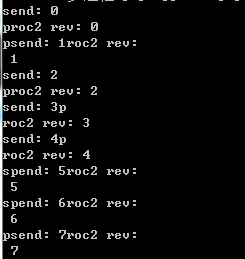Python多进程编程
序:multiprocessing
python中的多线程其实并不是真正的多线程,如果想要充分地使用多核CPU的资源,在python中大部分情况需要使用多进程。Python提供了非常好用的多进程包multiprocessing,只需要定义一个函数,Python会完成其他所有事情。借助这个包,可以轻松完成从单进程到 并发执行 的转换。multiprocessing支持子进程、通信和共享数据、执行不同形式的同步,提供了Process、Queue、Pipe、Lock等组件。
1. Process
创建进程的类:Process([group [, target [, name [, args [, kwargs]]]]]),target表示调用对象,args表示调用对象的位置参数元组。kwargs表示调用对象的字典。name为别名。group实质上不使用。
方法:is_alive()、join([timeout])、run()、start()、terminate()。其中,Process以start()启动某个进程。
属性:authkey、daemon(要通过start()设置)、exitcode(进程在运行时为None、如果为–N,表示被信号N结束)、name、pid。其中daemon是父进程终止后自动终止,且自己不能产生新进程,必须在start()之前设置。
例1.1:创建函数并将其作为单个进程
import multiprocessing import time def worker(interval): n = 5 while n > 0: print("The time is {0}".format(time.ctime())) time.sleep(interval) n -= 1 if __name__ == "__main__": p = multiprocessing.Process(target = worker, args = (3,)) p.start() print "p.pid:", p.pid print "p.name:", p.name print "p.is_alive:", p.is_alive()
结果
p.pid: 8736 p.name: Process-1 p.is_alive: True The time is Tue Apr 21 20:55:12 2015 The time is Tue Apr 21 20:55:15 2015 The time is Tue Apr 21 20:55:18 2015 The time is Tue Apr 21 20:55:21 2015 The time is Tue Apr 21 20:55:24 2015
例1.2:创建函数并将其作为多个进程
import multiprocessing import time def worker_1(interval): print "worker_1" time.sleep(interval) print "end worker_1" def worker_2(interval): print "worker_2" time.sleep(interval) print "end worker_2" def worker_3(interval): print "worker_3" time.sleep(interval) print "end worker_3" if __name__ == "__main__": p1 = multiprocessing.Process(target = worker_1, args = (2,)) p2 = multiprocessing.Process(target = worker_2, args = (3,)) p3 = multiprocessing.Process(target = worker_3, args = (4,)) p1.start() p2.start() p3.start() print("The number of CPU is:" + str(multiprocessing.cpu_count())) for p in multiprocessing.active_children(): print("child p.name:" + p.name + "/tp.id" + str(p.pid)) print "END!!!!!!!!!!!!!!!!!"
结果
The number of CPU is:4 child p.name:Process-3 p.id7992 child p.name:Process-2 p.id4204 child p.name:Process-1 p.id6380 END!!!!!!!!!!!!!!!!! worker_1 worker_3 worker_2 end worker_1 end worker_2 end worker_3
例1.3:将进程定义为类
import multiprocessing import time class ClockProcess(multiprocessing.Process): def __init__(self, interval): multiprocessing.Process.__init__(self) self.interval = interval def run(self): n = 5 while n > 0: print("the time is {0}".format(time.ctime())) time.sleep(self.interval) n -= 1 if __name__ == '__main__': p = ClockProcess(3) p.start()
注 :进程p调用start()时,自动调用run()
结果
the time is Tue Apr 21 20:31:30 2015 the time is Tue Apr 21 20:31:33 2015 the time is Tue Apr 21 20:31:36 2015 the time is Tue Apr 21 20:31:39 2015 the time is Tue Apr 21 20:31:42 2015
例1.4:daemon程序对比 结果
#1.4-1不加daemon属性
import multiprocessing import time def worker(interval): print("work start:{0}".format(time.ctime())); time.sleep(interval) print("work end:{0}".format(time.ctime())); if __name__ == "__main__": p = multiprocessing.Process(target = worker, args = (3,)) p.start() print "end!"
结果
end! work start:Tue Apr 21 21:29:10 2015 work end:Tue Apr 21 21:29:13 2015
#1.4-2加上daemon属性
import multiprocessing import time def worker(interval): print("work start:{0}".format(time.ctime())); time.sleep(interval) print("work end:{0}".format(time.ctime())); if __name__ == "__main__": p = multiprocessing.Process(target = worker, args = (3,)) p.daemon = True p.start() print "end!"
结果
end!
注 :因子进程设置了daemon属性,主进程结束,它们就随着结束了。
#1.4-3设置daemon执行完结束的方法
import multiprocessing import time def worker(interval): print("work start:{0}".format(time.ctime())); time.sleep(interval) print("work end:{0}".format(time.ctime())); if __name__ == "__main__": p = multiprocessing.Process(target = worker, args = (3,)) p.daemon = True p.start() p.join() print "end!"
结果
work start:Tue Apr 21 22:16:32 2015 work end:Tue Apr 21 22:16:35 2015 end!
2. Lock
当多个进程需要访问共享资源的时候,Lock可以用来避免访问的冲突。
import multiprocessing import sys def worker_with(lock, f): with lock: fs = open(f, 'a+') n = 10 while n > 1: fs.write("Lockd acquired via with/n") n -= 1 fs.close() def worker_no_with(lock, f): lock.acquire() try: fs = open(f, 'a+') n = 10 while n > 1: fs.write("Lock acquired directly/n") n -= 1 fs.close() finally: lock.release() if __name__ == "__main__": lock = multiprocessing.Lock() f = "file.txt" w = multiprocessing.Process(target = worker_with, args=(lock, f)) nw = multiprocessing.Process(target = worker_no_with, args=(lock, f)) w.start() nw.start() print "end"
结果(输出文件)
Lockd acquired via with Lockd acquired via with Lockd acquired via with Lockd acquired via with Lockd acquired via with Lockd acquired via with Lockd acquired via with Lockd acquired via with Lockd acquired via with Lock acquired directly Lock acquired directly Lock acquired directly Lock acquired directly Lock acquired directly Lock acquired directly Lock acquired directly Lock acquired directly Lock acquired directly
3. Semaphore
Semaphore用来控制对共享资源的访问数量,例如池的最大连接数。
import multiprocessing import time def worker(s, i): s.acquire() print(multiprocessing.current_process().name + "acquire"); time.sleep(i) print(multiprocessing.current_process().name + "release/n"); s.release() if __name__ == "__main__": s = multiprocessing.Semaphore(2) for i in range(5): p = multiprocessing.Process(target = worker, args=(s, i*2)) p.start()
结果
Process-1acquire Process-1release Process-2acquire Process-3acquire Process-2release Process-5acquire Process-3release Process-4acquire Process-5release Process-4release
4. Event
Event用来实现进程间同步通信。
import multiprocessing import time def wait_for_event(e): print("wait_for_event: starting") e.wait() print("wairt_for_event: e.is_set()->" + str(e.is_set())) def wait_for_event_timeout(e, t): print("wait_for_event_timeout:starting") e.wait(t) print("wait_for_event_timeout:e.is_set->" + str(e.is_set())) if __name__ == "__main__": e = multiprocessing.Event() w1 = multiprocessing.Process(name = "block", target = wait_for_event, args = (e,)) w2 = multiprocessing.Process(name = "non-block", target = wait_for_event_timeout, args = (e, 2)) w1.start() w2.start() time.sleep(3) e.set() print("main: event is set")
结果
wait_for_event: starting wait_for_event_timeout:starting wait_for_event_timeout:e.is_set->False main: event is set wairt_for_event: e.is_set()->True
5. Queue
Queue是多进程安全的队列,可以使用Queue实现多进程之间的数据传递。put方法用以插入数据到队列中,put方法还有两个可选参数:blocked和timeout。如果blocked为True(默认值),并且timeout为正值,该方法会阻塞timeout指定的时间,直到该队列有剩余的空间。如果超时,会抛出Queue.Full异常。如果blocked为False,但该Queue已满,会立即抛出Queue.Full异常。
get方法可以从队列读取并且删除一个元素。同样,get方法有两个可选参数:blocked和timeout。如果blocked为True(默认值),并且timeout为正值,那么在等待时间内没有取到任何元素,会抛出Queue.Empty异常。如果blocked为False,有两种情况存在,如果Queue有一个值可用,则立即返回该值,否则,如果队列为空,则立即抛出Queue.Empty异常。Queue的一段示例代码:
import multiprocessing def writer_proc(q): try: q.put(1, block = False) except: pass def reader_proc(q): try: print q.get(block = False) except: pass if __name__ == "__main__": q = multiprocessing.Queue() writer = multiprocessing.Process(target=writer_proc, args=(q,)) writer.start() reader = multiprocessing.Process(target=reader_proc, args=(q,)) reader.start() reader.join() writer.join()
结果
6. Pipe
Pipe方法返回(conn1, conn2)代表一个管道的两个端。Pipe方法有duplex参数,如果duplex参数为True(默认值),那么这个管道是全双工模式,也就是说conn1和conn2均可收发。duplex为False,conn1只负责接受消息,conn2只负责发送消息。
send和recv方法分别是发送和接受消息的方法。例如,在全双工模式下,可以调用conn1.send发送消息,conn1.recv接收消息。如果没有消息可接收,recv方法会一直阻塞。如果管道已经被关闭,那么recv方法会抛出EOFError。
import multiprocessing import time def proc1(pipe): while True: for i in xrange(10000): print "send: %s" %(i) pipe.send(i) time.sleep(1) def proc2(pipe): while True: print "proc2 rev:", pipe.recv() time.sleep(1) def proc3(pipe): while True: print "PROC3 rev:", pipe.recv() time.sleep(1) if __name__ == "__main__": pipe = multiprocessing.Pipe() p1 = multiprocessing.Process(target=proc1, args=(pipe[0],)) p2 = multiprocessing.Process(target=proc2, args=(pipe[1],)) #p3 = multiprocessing.Process(target=proc3, args=(pipe[1],)) p1.start() p2.start() #p3.start() p1.join() p2.join() #p3.join()
结果












![[HBLOG]公众号](https://www.liuhaihua.cn/img/qrcode_gzh.jpg)

